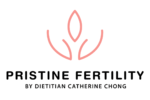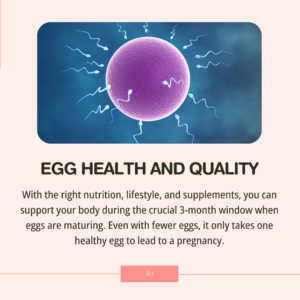Fertility After 35: What You Can and Can’t Control
If you’re navigating fertility after 35, you’ve probably felt the weight of statistics, timelines, and fears about running out of time.
Maybe you’ve even heard phrases like “diminished ovarian reserve” or “advanced maternal age” more often than you’d like.
But while there are things we can’t change, there is so much you can still influence, especially over the next 90 days.
Let’s break it down together, so you can focus on what’s within your control.
What We Can’t Change For Fertility After 35
We can’t sugar-coat this: fertility does decline with age, and there are some biological truths we must acknowledge. But understanding these facts helps us channel our energy into what we can influence.
1. The number of eggs we’re born with
Unlike men who produce new sperm constantly, women are born with all the eggs they’ll ever have. By the time we hit our 30s, especially after 35, that number significantly declines.
Fertility naturally decreases due to a drop in egg count and quality. Most women are born with 1–2 million eggs, but by the mid-30s, this reserve significantly decreases in both number and proportion of genetically healthy eggs.
2. The natural decline in egg quantity with age
As women age, the number (ovarian reserve) and the quality of eggs decline significantly. This natural process, called atresia, means that each cycle recruits a group of eggs, but only one typically matures for ovulation while the others are lost. Over time, this loss becomes more pronounced, and egg quality deteriorates due to cumulative DNA damage and mitochondrial dysfunction.
3. Our genetics and chronological age
Our DNA, family history, and age are part of the equation. These factors impact how many eggs we have left, how they respond to hormonal signals, and how well they mature. New research has shown that genetics may play a bigger role than we once realised.
An extensive study using advanced genetic testing found that nearly one in four women with unexplained diminished ovarian reserve (DOR) had identifiable genetic changes that impacted egg quality, mitochondrial function, or DNA repair.
This highlights how fertility after 35 isn’t just about the number of eggs you have. It’s also about how well those eggs are protected, nourished, and supported during development.
And importantly, while we can’t change our DNA, we can create the best possible environment to protect and nurture the eggs we have.
What You Can Influence to Boost Fertility After 35
New eggs are recruited daily for development, and this maturation process takes about 90 days. That gives us a powerful window of opportunity even after 35 to nourish, protect, and optimise your eggs.
1. Egg health and quality
Through nutrition, lifestyle, and supplementation, we can influence the health and quality of the eggs that develop during this 3-month window. Even if the quantity is lower, healthy, high-quality eggs still have the potential to fertilise and develop into strong embryos. It only takes one healthy egg to create a pregnancy.
2. The follicular environment

Eggs grow inside follicles, which are filled with fluid. This follicular fluid acts like a nutrient soup; it reflects your body’s internal health.
Emerging research shows that a follicular environment rich in antioxidants and low in inflammation is strongly linked to better egg maturation, fertilisation, embryo quality, and implantation success. An anti-inflammatory, antioxidant-rich diet can improve this environment, giving your eggs the best possible start.
3. Mitochondrial function

Inside each egg are mitochondria, the “powerhouses” that generate the energy needed for fertilisation and early embryo development.
New research highlights that as we age, mitochondrial function and mitochondrial DNA copy numbers decline, contributing significantly to ovarian aging and reduced egg quality. Supporting mitochondrial health through antioxidant-rich nutrition and lifestyle strategies is one way to help protect egg quality and boost fertility after age 35.
4. Hormonal balance
Your hormones are messengers that guide the egg’s development, ovulation, and the thickness of your uterine lining. Blood sugar imbalances, stress, a poor diet, and sleep issues can all disrupt this delicate balance, but the good news is that these are modifiable factors.
New research shows that high-fat, high-calorie diets can disrupt hormone production, increase oxidative stress, and impair the development of ovarian follicles. However, a diet rich in antioxidants, including phytonutrients, vitamins, and organosulfur compounds such as those in garlic and broccoli cabbage, may help protect ovarian function, support healthy hormone signalling, and improve oocyte quality.
5. Oxidative stress and inflammation

These are silent threats to egg quality. They can damage DNA inside the egg and disrupt fertilisation. Recent research found that women with higher levels of oxidative and inflammatory markers in their follicular fluid had lower egg maturity, poorer embryo quality, and reduced pregnancy outcomes, particularly after 37 years of age.
But again, with the proper nutrition and lifestyle strategies (such as cutting back on processed foods, reducing exposure to toxins, and managing stress), we can minimise their impact.
Visit our previous blog post here to explore five powerful fertility-boosting foods that enhance reproductive health and help increase your chances of conception.
Bottom Line
Some factors like age, genetics, and the natural decline in egg quantity are outside of our control, but understanding them helps us focus on what we can influence.
You have a powerful window of opportunity every 90 days to nourish, protect, and optimise the eggs developing right now through the right nutrition, lifestyle, and environment.
- Small, consistent changes, such as eating antioxidant-rich foods, supporting mitochondrial health, balancing hormones, and reducing oxidative stress, can make a meaningful difference in boosting fertility after 35.





